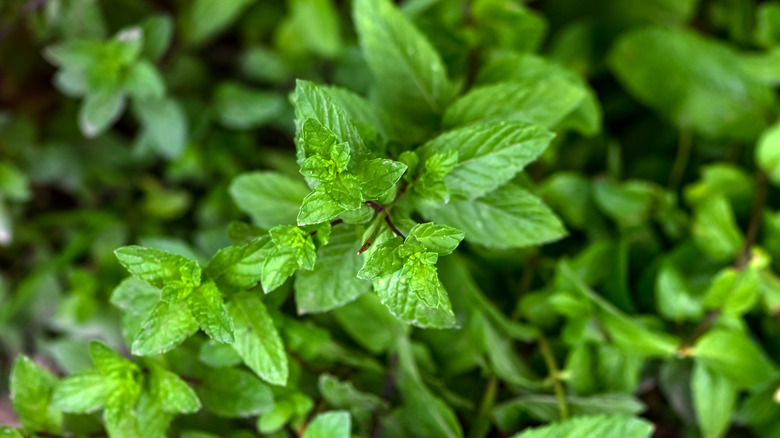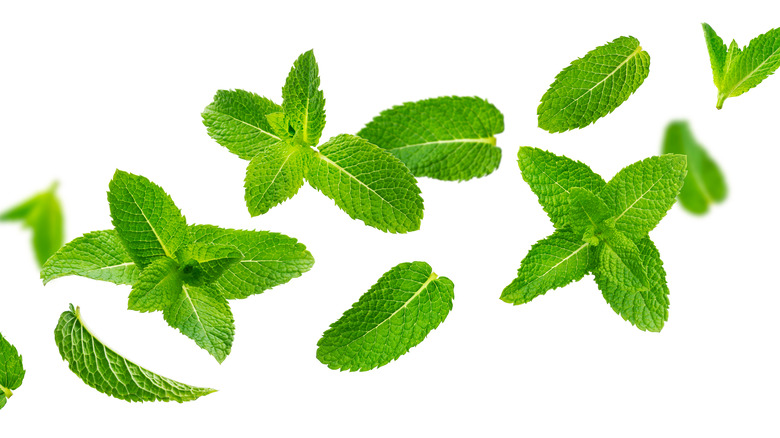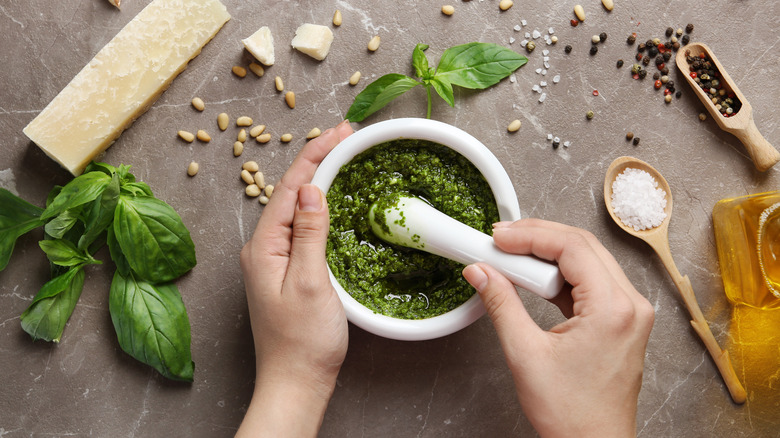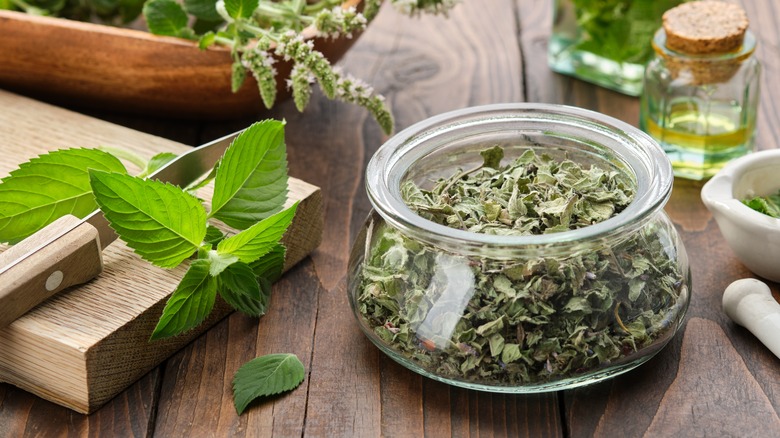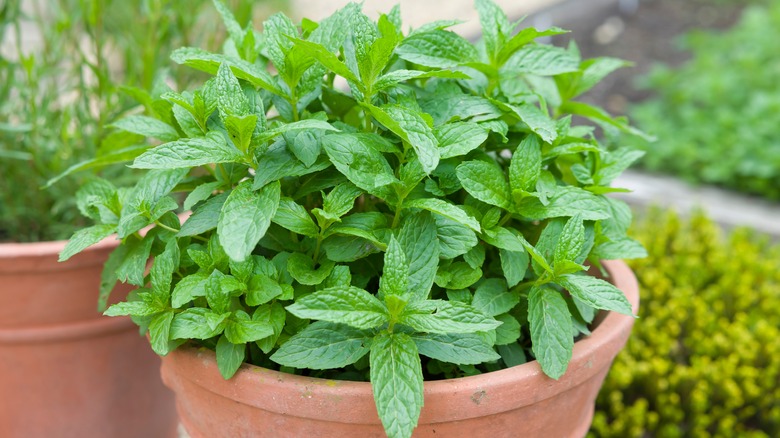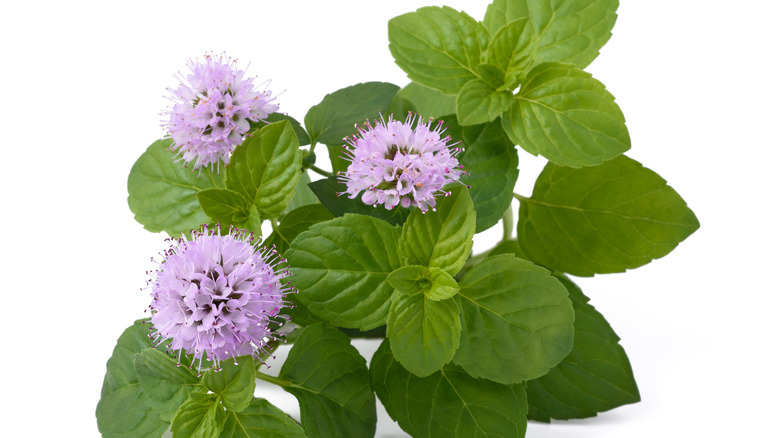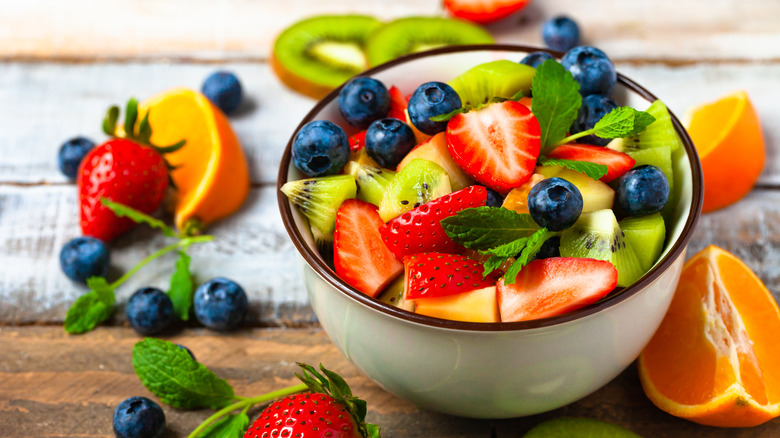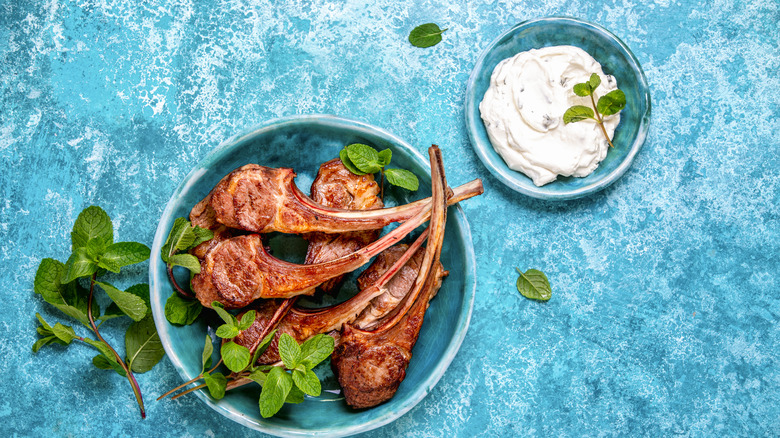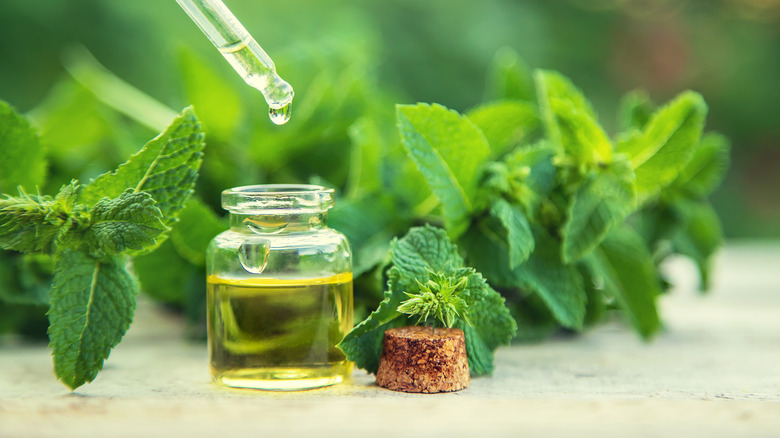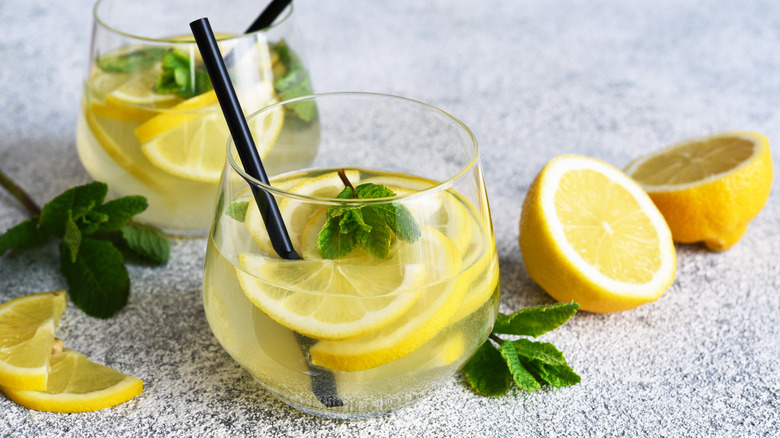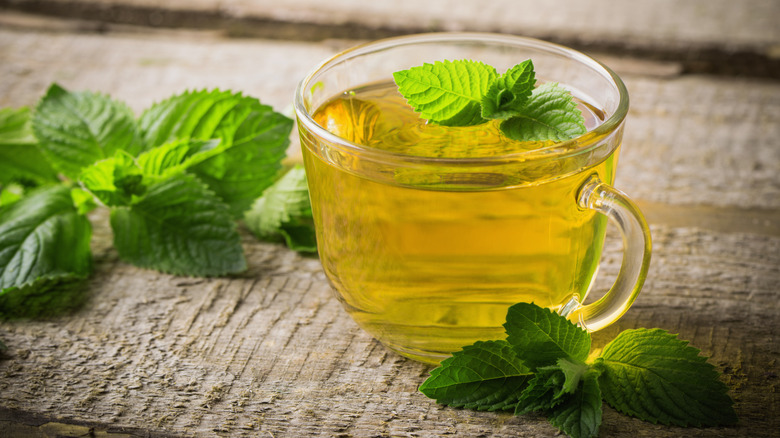10 Tips You Need When Cooking With Mint
Mint has long been one of the most versatile and ubiquitous herbs used by people all over the world. Mint is used in sweet and in savory dishes, in drinks, and even in medicinal applications. In fact, according to JSTOR, mint shows up in an Egyptian medical text from around 1500 BCE.
But before delving in, it might be worth asking: Just what exactly is mint? The answer might be broader than you realize. Per Encyclopedia Brittanica, mint encompasses 25 species of the Lamiaceae family. There is a wide range of types of the plant, ranging from the more common (like spearmint and peppermint) to potentially dangerous species, like pennyroyal.
Of course, mint's sheer range can sometimes make using the plant in cooking daunting: What types of dishes benefit from mint? How much do you need? And are all mints the same? In practice, there is definitely some subtlety to be found when cooking with mint. Read on to learn a little more about the plant, and some tips for effectively using it in recipes.
Not all mint is the same
As mentioned above, the mint family has a comprehensive and wide range of plants. Some are stronger than others, and flavors vary, so prepare your dishes accordingly. As described above, spearmint and peppermint are among the most popular forms of mint used in cooking today. Even if you haven't extensively used mint in your cooking, you may well be able to identify the difference in aroma between the two.
And that distinction actually points to some serious differences between these two forms of the plant. For one thing, the concentration of menthol is way higher in peppermint than in spearmint, making the herb much more intense, and more applicable to certain dishes (like cocktails, or desserts) when you want to reveal its intense flavor. Spearmint, by contrast, tends to be subtler and works well in dishes where you want a hint of mint, but don't want to overpower other flavors.
Try using mint paste
Mint paste is not necessarily in every cook or baker's toolkit — but it can be a handy way to add mint flavoring to lots of dishes. While you can buy it at plenty of grocery stores, mint paste is actually very easy to make at home. Known as pudina paste or pudina ka paste in Indian cuisine, mint paste in its simplest form is simply mint leaves blended with water or oil into a paste. Depending on your intentions, it can have additional flavorings, like garlic or chiles to spice it up. It can also be thicker or thinner, per your intentions.
Why use mint paste and not fresh or dry mint? In practice, there are many effective ways to add mint flavor to a dish, and those other options certainly work well much of the time. But mint paste can be particularly handy in settings where its viscous quality can either thicken or blend neatly into your recipe, like in pestos, chutneys, and marinades.
Preserve your own mint
Mint is a highly prolific herb; as any gardener or farmer can attest to, mint is extremely vigorous, naturalizes easily, and is difficult to remove once established in open land. The upside to this is that mint is versatile and has many uses, so it is almost always needed.
Plus, mint can be preserved very easily. Whether you have the space to grow your own mint or not, home preservation is not difficult, and can be done with mint you grow, buy from the grocery store or farmers' market, or even forage. There are, in fact, multiple ways to effectively preserve mint and keep it for short-term or long-term use. Freshly picked or purchased mint can easily last a few days or longer on the stem, in water, or the refrigerator. For longer-term uses, freezing mint — either in ice trays with water or as individual leaves — works well, as does drying mint. Drying can be done either with a home dehydrator or by hanging the leaves upside-down in paper bags for a couple of weeks.
Grow mint at home
Maybe you're fortunate enough to have garden space to grow mint at home. But even if you don't — and in fact, even if you do, given mint's propensity to outcompete other plants, per Gardening Know How — growing mint in pots can be a great way to keep a supply of the fresh herb on hand.
Mint is a great herb to grow, whatever your level of experience. Mint grows quite easily across many climates. Even a single pot can be a nice way to keep a fresh supply of the herb on hand — and as with pretty much any food, you can't beat having it fresh. Mint can tolerate partial shade and likes to grow in moist and well-drained soil. Conveniently, mint also grows well from cuttings, which means it can typically be cultivated easily from a friend or family member's mint plant. Planting mint in pots also allows for variety: You can keep spearmint in one pot, peppermint in another, and potentially experiment with other mint types as well.
Don't throw away mint stems
Mint is a beautiful plant, under ideal conditions growing tall and producing beautiful pink, white, and purple flowers, per Farmer's Almanac. When cooking with mint, the focus is naturally on the leaves, the richest and most flavorful parts of the plant. But you shouldn't forget about the stems, and just because they are secondary doesn't mean they have no purpose. In fact, mint stems can be a helpful addition to many recipes, and should not be instantly discarded. What are they good for? In practice, anything where the mint flavor — and not the texture — is of paramount importance can usually benefit from stems.
Their woody texture is not necessarily appetizing, but in blended dishes, or dishes where mint is being pulverized or strained — for instance, in pestos, or in mint-flavored infusions — the stems can help to impart an added dose of mint to whatever it is you are making.
Avoid using too much
Mint can actually be a pretty strong herb — sometimes quite a bit stronger than you might expect. While mint is very nutritious — rich in vitamin A, iron, manganese, and folate, among other benefits, per Healthline — it is also especially potent. Using it as a subtle complement in foods is great, but too much can be greatly overpowering, obscuring other flavors.
Part of this does come down to which type of mint you use. As described above, peppermint has a much higher menthol concentration than spearmint. Accordingly, you will want to be particularly cautious when adding peppermint to recipes, and if you are only looking to bring some subtle flavor to a dish you're making, particularly a savory recipe, spearmint may end up being the safer choice. Need an example of how much to use? A few sprigs of mint are more than enough in this mint and melon fruit salad.
Incorporate mint into savory dishes
Despite sometimes having a sweeter or more dessert-friendly reputation, as alluded to above, mint's flavor can add a striking complement to savory meals. The unique flavors of mint offer a fantastic complement to rich, savory foods. In fact, mint is arguably one of the most widely used flavorings in cuisines worldwide, ranging from its role in Indian curries to Moroccan chutneys to Mexican soups, and much more. Its slightly cooling flavor can provide a refreshing contrast to hot and spicy dishes, while also helping to accent other spices and flavors.
In other words, if you've gotten used to seeing mint just as a garnish on slices of chocolate cake, or as an ingredient in your mixed drink of choice, it's worth considering how much more you can do with it. For something unique, try making toast with fava beans and mint for a switch up from your usual toast toppings.
Try making your own extract
Thus far, we've covered a few ways to add mint to recipes: You can use fresh mint, you can use dried (purchased or home-dried), or you can make or purchase mint paste. One other way to quickly add mint flavor is with mint extract. Like vanilla extract, mint extract is particularly useful in baking, and can often be found in stores; a pre-made version (like this standard version from McCormick) is just alcohol, water, and mint oils.
Fortunately for the home cook, mint extract is actually pretty easy to make at home, requiring only a couple of ingredients, a few materials, and a little bit of time. Making your own mint extract basically just entails taking fresh mint, crushing the leaves, and letting them infuse in vodka for a couple of months. Mint extract should keep a long time, and can be used in plenty of tasty recipes — like this one for homemade peppermint ice cream.
Include mint in drinks
Thus far, we've pretty much stuck to talking about mint in foods — for good reason! In desserts, savory dishes, salads, and other foods, mint can play a critical (sometimes even paramount) role. But it is important not to neglect drinks: Mint is, in fact, a staple of a number of cocktails and other drinks, including some non-alcoholic ones.
Mint's refreshing, cool flavor makes it essential to mint juleps, which call for making mint simple syrup (boiling water and sugar, then adding fresh mint leaves), and garnishing the drink with fresh mint. Mint is also vital, and used in a similar way, in this mojito recipe, pairing nicely with the citrus-y lime flavor and rum. And if you're not a drinker, know that mint is not just useful in alcoholic drinks. It can be just as refreshing in non-alcoholic beverages — consider making mint-infused ice cubes, which can be added to any beverage you want.
Use it to help digestion
Because we have largely focused on mint's role in foods (and drinks), we have not talked too much about one of the other vital roles mint has played, both historically and in the present day: Its role as a medicine. Indeed, mint's long history as medicine is well-documented and has been used for stress, for better sleep, and even for its anti-fungal and antibacterial properties in protecting other plants. But perhaps most relevant to the list above, mint is also a potent herb for managing stomach pain, helping to ease indigestion and cramping, among other symptoms.
Mint can thus play an important role around your meals: Enjoying a warm cup of mint tea after a meal can be a relaxing and tasty way to ease digestion, helping your stomach process what you just ate and, depending on the time of day, also help with sleep.
